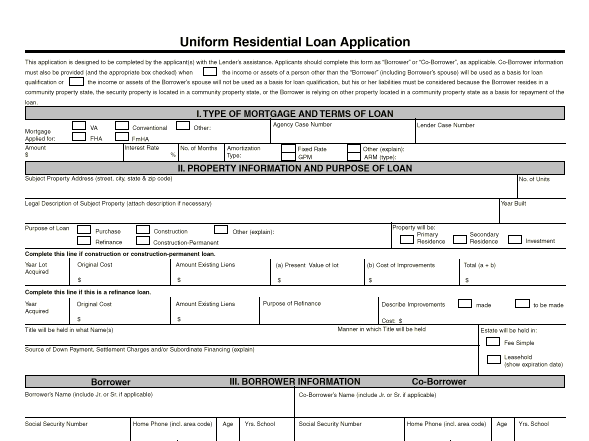How to Fill Out the Uniform Residential Loan Application (Form 1003)
Post on: 29 Май, 2015 No Comment

TERMINOLOGY
The uniform residential loan application is used on all mortgage loan purchases. The borrower will fill it out with the help of the lender, and this will provide the lender all of the information needed to properly approve or deny your loan. You will need to have some information or documents handy in order to fill out the application properly.
Type of Mortgage and Terms of Loan
This section is simply asking what kind of mortgage product you are looking for. You can apply for multiple types to see which is the best for you. It is also asking what term—such as 15 or 30 years—you want for your mortgage.
Here you will put in your current address if you are refinancing or the address of the new home that you are purchasing. You will need to provide the loan amounts needed, and you can designate whether you need a construction loan .
The borrower information section asks for all identifying information, such as your Social Security number, date of birth, address and phone numbers, plus information about spouses or dependents.
You will need to supply the lender with information about your job. They need to know what you do, how much you make, where you work and how long you have been at your job. If you have not been at your job for at least two years, they will want information about past jobs also. When giving information about how much you earn, you use your pre-tax income.
This section includes information the lender needs to determine your debt -to-income ratio, an important aspect of your loan approval. You list your income again, and then you list all housing costs, such as your mortgage payment, insurance, taxes and homeowners’ association dues. If you are buying a home, you use the proposed new payment information.
You will have to list all assets, such as real estate with equity. bank accounts and retirement accounts. Then you list all liabilities. This is to determine how much debt you have in relation to your income. Liabilities include loan and other debt information like mortgage, car and student loan payments and credit card balances. You don’t list items like phone, cable or electric bills.
This is likely filled in by the lender, because this includes purchase price, down payment. closing costs, points paid, hazard insurance and private mortgage insurance.
Declarations are stating whether you are involved in a lawsuit, had a foreclosure. are a resident alien or borrowed the down payment. The lender is just making sure that, once you are granted the loan, no one can come after you and put a lien on it for an outstanding judgment.














